Does reverse osmosis remove giardia?
Yes, the reverse osmosis filtration system is 100% effective in removing giardia from water.
How does a reverse osmosis water filter remove giardia from water?
All reverse osmosis water filters use a special Reverse osmosis membrane to remove impurities from water. The pore size of this membrane is only 0.0001 micron. A RO water filter uses an electric pump to push water through the membrane. Nothing but pure water molecules can pass through the membrane.
Typically, a giardia cyst is about 10 to 15 microns long and 7 to 10 microns wide. In comparison, a single giardia cyst is at least 7000 times bigger than the pore size of a RO membrane.
So, when giardia-contaminated water gets pushed by the RO water pump, all giardia cysts get stuck in the RO membrane. That’s why water purified by an RO water filter is considered 100% giardia free and safe for drinking.
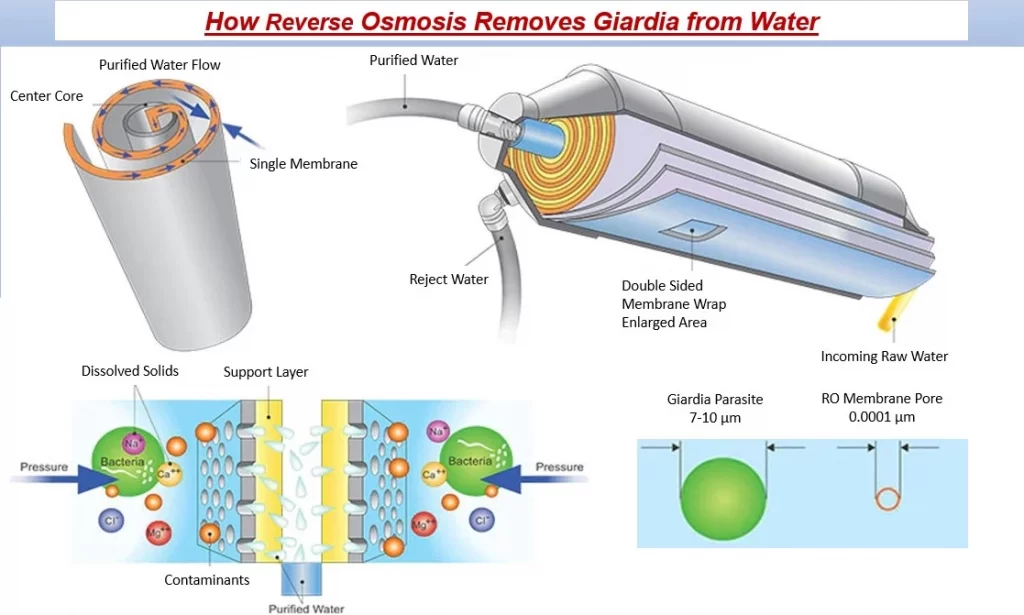
Our preferred Best Giardia Water Filters
All NSF 58 certified reverse osmosis water filters can remove giardia from drinking water. But our most preferred one is the WaterDrop G2 tankless reverse osmosis water filter.
Install a Home Water Filter & Get "Unlimited Safe Drinking Water" For Decades
Get Upto 55% Discount With a Lifetime Warranty & 6-Months Money Back Guarantee Free Shipping
SpringWell Water Filtration Systems: 100% American-Made & NSF Certified Water Filters and Water Softeners
It can purify 400 gallons of water per day (0.28 Gallons Per Minute). It is not only capable of removing giardia but hundreds of other pollutants that might be present in drinking water. It filters water in 5 stages and thus removes bad taste, and rotten smell.
WaterDrop G2 hardly takes up any space in your kitchen thanks to its stainless design. In addition, waterdrop offers a Nickel-Based faucet with a filter.
Our Readers Get an Exclusive 10% Discount on all WaterDrop Water Filters. Click Here to Apply Coupon Code: Open-air-home-10
And for those who want to avoid the hassle of installing a water filter in the kitchen, the AquaTru countertop RO Water filter would be an ideal choice. It is the number one selling installation-free water filter on Amazon.
It also got NSF certification for removing all kinds of parasites, bacteria, and viruses from water. With only 100 gallons a day of water filtering capacity, it is a bit slower than WaterDrop G2. But if you have a small family that does need a ton of water, Aquatru can serve you just fine.
By the way,
Reverse osmosis is not the only process you can use to get rid of giardia. There are other ways to kill giardia like using disinfectants, ozone purification process, water boiling, etc. In this article, we are going to discuss everything there is to know about giardia and possible ways to keep it away from humans as well as animals.
What is Giardia, and what is Giardiasis?
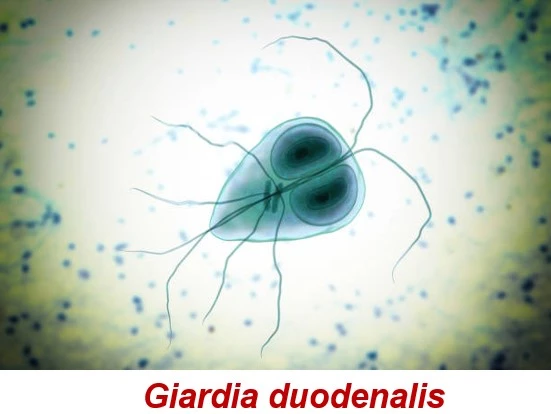
Giardia refers to a group of microscopic parasites that can be found all over the world. As of now, 6 distinct species of giardia have been found in humans and other mammals. Among them, Giardia duodenalis is the most common species. It is also known as Giardia lamblia and Giardia intestinalis.
Upon ingestion, it infects the intestines and causes a diarrheal disease called Giardiasis. Giardiasis significantly contributes to the 179 million cases of diarrhea reported in the U.S.A each year.
What are the symptoms of giardiasis?
Giardia parasites can infect both humans and pets. Symptoms of giardiasis disease in humans include:
- Diarrhea
- Gas
- Foul-smelling, greasy poop that can float
- Stomach cramps or pain
- Upset stomach or nausea
- Dehydration
Symptoms of giardiasis disease in pets include:
- Diarrhea
- Vomiting
- Decreased appetite
- Decreased energy
- Excess foul-smelling gas
- Frequent urges to poop
Is Giardia contagious?
Giardiasis is an extremely contagious disease. Giardia parasites can easily transmit from humans to humans, animals to animals, and humans to animals.
How do you people get giardia infection?
The life cycle of Giardia can be divided into 2 stages.
- Cyst
- Trophozoites
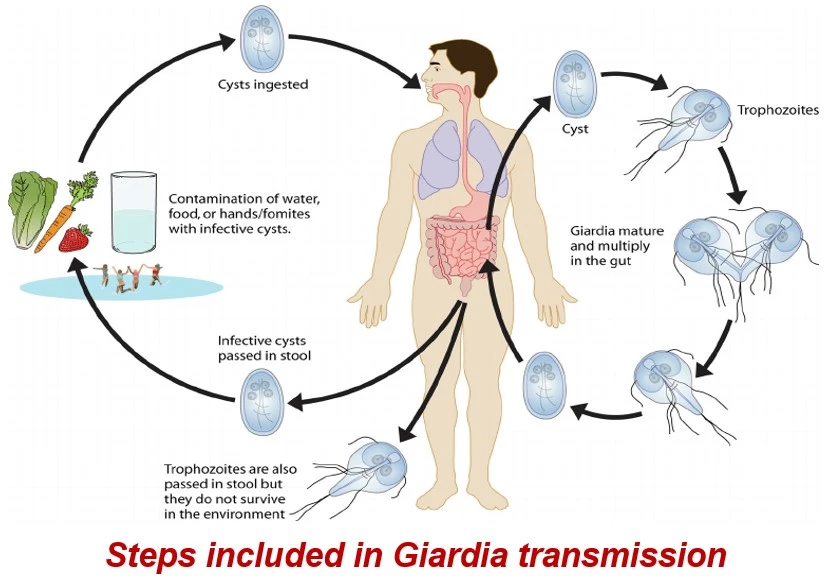
A single giardia parasite starts its life as a cyst. A cyst is like an egg that has a hard and sturdy form. In the cyst form, giardia can survive in the environment for a couple of months.
Giardia infects people and animals when its cyst gets swallowed with food, water, or other drink. Upon entering the host’s body, it reaches the intestine where a single cyst produces two Trophozoites.
In the intestine, Trophozoites attach themselves to the mucosa by a ventral sucking disk. There they multiply by longitudinal binary fission. In 1-2 two weeks, they create millions of cysts and trophozoites and infect the host.
They come out of the host’s body through feces and continue to infect nearby people, pets, and other animals.
How do giardia parasites transmit from one host to another?
The experts at CDC have recognized giardiasis as a waterborne disease. In 90% of the cases, people and animals get giardia infection by drinking contaminated water.
A single infected host whether it’s a human or an animal can release millions of giardia parasites in a single bowel movement. Those parasites can find their way to various water bodies because of sewage overflows, dysfunctioning sewage systems, etc. Giardia can also enter into natural water sources like lakes, streams, etc due to polluted stormwater runoff, and agricultural runoff.
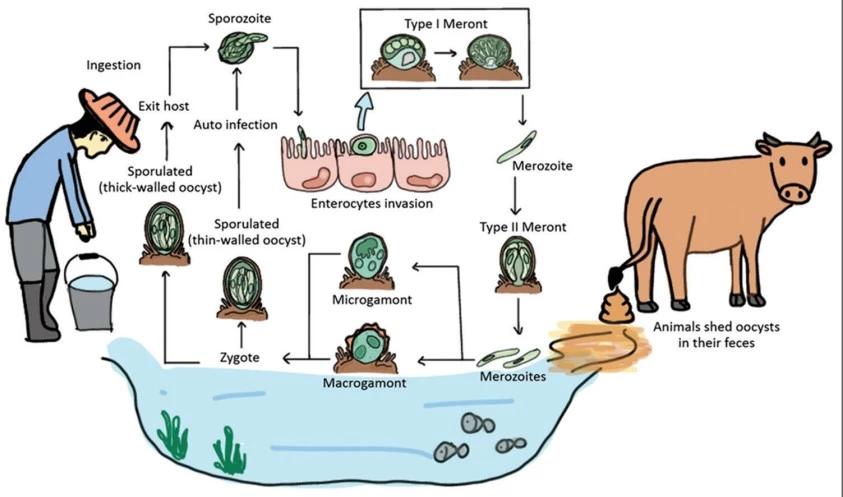
Shallow wells and deep wells that provide drinking water to millions of Americans can also be polluted with giardia during floods.
Since giardia can live in nature for a couple of months, it is very easy for them to pollute water and get transmitted from one host to another.
How to prevent Giardia infection?
Here are a few steps that you can follow to prevent giardia infection.
- Don’t swallow unsafe food or water. Always filter water if you suspect it is contaminated with Giardia germs.
- Keep a safe distance from someone who has Giardiasis, especially in hospitals.
- Use a face mask and hand sanitizer during visiting hospitals, public places, and areas that have poor sanitation
- Giardia parasites can easily contaminate surfaces like bathroom handles, changing tables, diaper pails, or toys. Don’t put your hand to your hand right after you touch one of those surfaces.
- Don’t come in contact with infected animals or animal environments contaminated with poop.
How to kill giardia in water?
As mentioned before, using reverse osmosis water filters is by far the most effective and quick way to remove giardia from drinking. However, you can also use water purification tablets or boil water to kill giardia parasites.
Boil water to kill giardia:
Giardia, in cyst form, cannot survive in water at temperatures above 129.2°F (54°C). As we all know, water boils at 212°F (100°C) which is far above the surviving temperature of giardia. If you boil drinking water for 5-6 minutes, it will be 100% giardia free.
Use water purification tablets to kill giardia:
In places, where boiling drinking water is not an ideal option, you can use water purification tablets to destroy Giardia in drinking water. Our preferred EPA registered water purification tablet, Katadyn Micropur MP1, releases CHLORINE DIOXIDE that can kill 99.9% of viruses, bacteria, Giardia, and Cryptosporidium in all water conditions.
The only disadvantage of this method is that it takes at least 30-45 minutes to get safe drinking water.
Does bleach kill giardia in water?
Yes, bleach can kill giardia. You can create a bleach-water solution by mixing 1 cup (8 ounces) of bleach in 1 gallon of water to disinfect germ-contaminated surfaces. The solution’s effectiveness can vary depending on the water temperature and bleach strength.
Remember, the bleach-water solution is not safe for drinking. And if you use it to decontaminate plates, spoons, and other cooking pots, thoroughly rinse them with sterile water at the end.
Edward L. Jarrol, Alan K. Bingham, and Ernes A. Meyer published a research paper, “Effect of Chlorine on Giardia lamblia Cyst Viability”, which shows bleach-water solution made with 25°C (77 °F) water can kill all of the Giardia cysts in under 10 minutes. If the solution temperature drops below 15°C (59 °F) it kills only 80-90% of cysts. For that, it takes about 30 minutes or so.
The paper concludes that as the solution temperature drops, its effectiveness diminishes, especially in the winter seasons.
In case you want to avoid confusion and the hassle of making a bleach solution, get EPA registered ‘Hospital Grade’ CleanSmart Liquid Chlorine Disinfectant from Amazon. It can kill up to 99.9% of viruses, bacteria, and parasites. Simply put the liquid in an electrostatic sprayer and spray over suspected Giardia-contaminated surfaces.
Frequently Asked Question about Giardia
Does lysol kill giardia?
Yes lysol can kill giardia.
Does sunlight kill giardia?
Yes, direct sunlight can kill giardia.


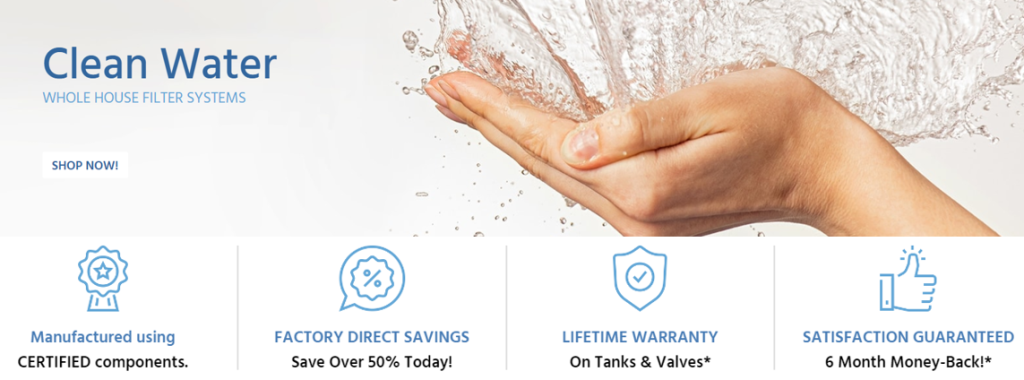

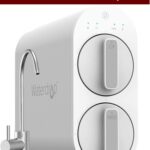
[…] Remove Giardia From Drinking Water By Reverse Osmosis […]
[…] Does reverse osmosis remove giardia? […]